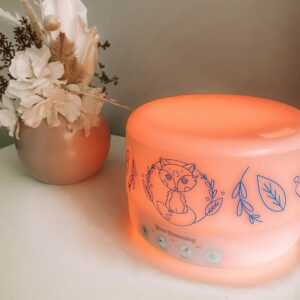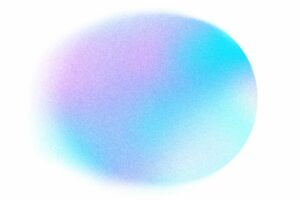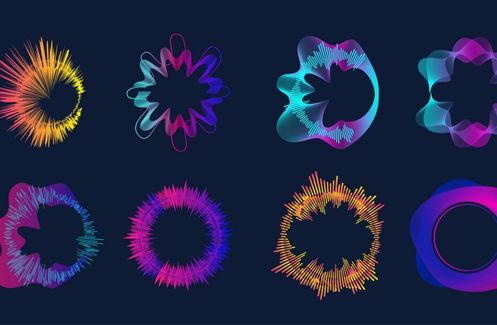Table of Contents
Brown noise, pink noise, green noise – discover the calming & soothing benefits of coloured noise and find out which is the right one for you
Whether you have ADHD, problems concentrating, sleep struggles, or you live or work in a noisy environment -coloured noise might be a winning solution to help soothe your mind.
Coloured noise has been a huge trend on TikTok and other social media platforms, so Healthista got the lowdown on everything to do with coloured noise, from the difference between them to which one is the best for you.
We quizzed Dr. Naomi Newman-Beinart (PhD), Health Psychologist, nutritionist and spokesperson for sleep brand Glow Dreaming and Martin Seeley, the CEO at MattressNextDay.
‘Just like eating and drinking, sleep is an essential human need,’ explains Dr Naomi.
‘Sleep affects emotional, mental and physical wellbeing, and healthy sleep is especially important for children as it supports good immune health, learning, memory, growth and development.
‘Our environment contains a mix of white, pink and brown noises, amongst other types of coloured noise. These three types of coloured noise are most commonly used to help block ambient noise and help with sleep’.
Coloured noise has been a huge trend on TikTok and other social media platforms
‘Coloured noises are designed to create a uniform sound that doesn’t stimulate your brain to have a sudden reaction,’ explains Martin.
‘In turn, it also helps protect your ears from any disruptive background noise, such as a car driving past your window, which can prevent you from falling into a slumber.
‘However, many people are unaware that different coloured noises have different benefits and can, therefore, be used to solve many sleep problems’.
READ MORE: Why can’t I sleep? 8 reasons your gut health could be to blame

So, what colours are there and what should we be listening to?
White noise
Best for: those that suffer from insomnia, or for children with ADHD.
‘White noise is a man-made sound that includes low, medium and high frequency sounds, like the steady hum of being on a plane, and prevents sudden noises from interrupting your sleep,’ explains Dr Naomi.
Insomnia is the most common issue for one in 12 Britons diagnosed with a sleep problem. But, white noise is a good mask for those with insomnia, as it’s an equal amount of all audible sound frequencies at once.
like the steady hum of being on a plane
‘Think of white noise as a clean white sheet for your ears, that blocks out all other noise disturbances,’ says Martin.
‘It sounds like the faint static of a fan or TV static. However, this type of noise isn’t for everyone, as it emphasises high-frequency sounds which can be too noisy for some people’.
That being said, white noise has been reported to help toddlers fall asleep. TikTokers have stated that white noise can benefit children with ADHD and improve their performance on memory and verbal tasks and ease anxiety.
READ MORE: Can’t sleep? These 20 healthy foods could be the cure

Pink noise
Best for: light sleepers or those that wake up with low energy.
Pink noise creates a harmonious balance of both high an low frequencies, which mimic the sounds found in nature.
Martin Seeley, CEO and sleep expert at MattressNextDay, says
‘Pink noise uses deeper sounds compared to white noise, so it can appear to be more soothing and gentler on the ear,’ Martin describes.
Indeed, studies have found that pink noise helps you spend more time in deep sleep, which means that you wake up with more energy.
pink noise is a good option for those who find white noise annoying
‘Pink noise is less intense than other types of coloured noise and is considered to be more soothing,’ explains Dr Naomi.
‘In fact, pink noise is a good option for those who find white noise annoying’.
Research has shown that pink noise relaxes and calms the mind, preparing it for all-important deep sleep, called Slow Wave Sleep.
In a small 2012 study in the Journal of Theoretical Biology, researchers found that steady pink noise reduced brain waves, which increased stable sleep.
A 2017 study in Frontiers in Human Neuroscience also found a positive link between pink noise and deep sleep.

What’s more, several studies on pink noise have shown that sleeping with it can improve our memories the following day, and potentially even long-term, which is an added bonus if you’re using pink noise to help your child sleep and potentially improve their learning.
Dr. Naomi recommends Glow Dreaming – a 5-in-1 sleep aid that is scientifically engineered for sleep.
The speaker has been designed to allow it to produce the sound frequency of true pink noise, as pink noise can’t really be created using a little speaker found in a device or on your phone.
‘It just doesn’t get the depth of sound needed to help the brain get into the delta wave sleep patterns we all need,’ explains Dr Naomi.
Glow dreaming also uses a red light to help stimulate melatonin production, an aromatherapy diffuser and a built-in humidifier – all you need for a good night’s sleep.
Brown noise
Best for: those that live in loud, busy areas or those that struggle to drown out internal thoughts at night.
Brown noise is deeper than pink, as it has higher energies at lower frequencies. It has been described as a ‘rougher’ sound than pink noise and resembles the roar of a river current or strong wind.
With brown noise, you can hear every frequency that the ear can detect
‘While there is a lot less research on how brown noise can help you sleep and impacts each person differently, it has been reported to induce sleep and help with relaxation,’ Martin reveals.
‘With brown noise, you can hear every frequency that the ear can detect, so it can create an immersive experience that smothers other thoughts, meaning you can focus on one clear thing – such as relaxing, reading or sleeping.
‘This also makes it the best-coloured noise for those that struggle to drown out their internal thoughts at night’.
READ MORE: 5 ways to ease anxiety during menopause

Green noise
Best for: those who are stressed and struggle to switch off at night.
Green noise is a variation of white noise in the middle of the spectrum. But as its name suggests, many of the sounds are what we would consider nature – think of it like ocean waves.
Green noise frequency is not particularly high – the higher the frequency gets, the more sensitive we are – so it is good for those who like ambient noise in the background when trying to sleep.
good for those who like ambient noise in the background
‘Some great examples of green noise can be the sound of water on a beach, or trickling waterfalls – anything that is attuned to nature and promotes relaxation,’ Martin explains.
‘If you are struggling with stress in everyday life, this type of noise could help restore some sense of calm’.
‘If you are someone who finds the sound of a fan soothing at night, then green noise might be the one for you,’ says Dr Naomi.
‘The low frequency means it’s not too loud and can help you relax at bedtime’.
READ MORE: This Morning’s Dr Zoe Williams reveals 7 things she has learnt since becoming a mother

Grey noise
Best for: those that have tinnitus.
To describe grey noise, it would be that it’s similar to white noise but more balanced, as it produced noise at high and low frequencies.
As every person hears differently, grey noise sounds different to each ear, but it is often used to help drown other sounds especially for people with tinnitus, who are sensitive to everyday sounds.
READ MORE: What is Energy Based Therapy and how can it help?

Blue noise
Best for: those that have tried every coloured noise option but prefer something higher pitched.
While not often used widely as sleep support, that’s not to say blue noise can’t aid with sleep for some people.
‘Blue noise is, essentially, noise that contains all the audible frequencies, but the high frequencies are amplified,’ explains Martin.
Blue noise is a little harsher in sound
‘Think of the opposite of the low frequencies of brown noise, as this noise is akin to a hissing tap. Though it might not sound very relaxing, sleepers who aren’t as sensitive to higher-pitched sounds may prefer blue noise’.
‘Blue noise is a little harsher in sound compared to the other coloured noises and is not usually recommended for people who want to use coloured noise to help them get a better night’s sleep,’ Dr Naomi adds.





More Stories
Punching Through History: A Spotlight on Boxing Culture in England’s Reading
The Link Between Vitamin E Intake and Parkinson’s Disease
Tips and Techniques for Moving Past Binge Drinking